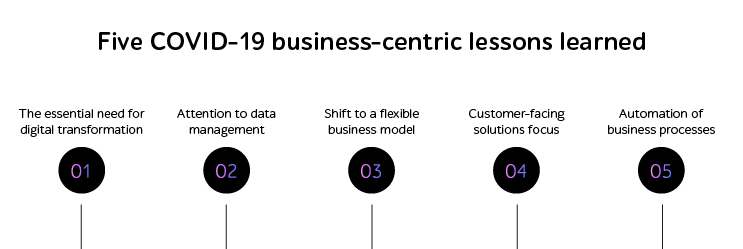
5 lessons we learned from COVID-19
The forced changes in the global context due to the spread of the COVID-19 virus have affected many areas of our lives. Right now, we are observing the onset of a global crisis that is turning our understanding of digital space upside down.
Take the promotion of home self-isolation as an example. It has stimulated a growing interest in online services. In the USA alone, Internet traffic has increased by 20%. Unfortunately, not all websites and mobile apps were prepared for such a large-scale online migration.
We still have time to rectify the situation. Here are five key lessons the businesses need to learn during this pandemic to somehow achieve the planned outcomes.

The need for digital transformation
The demand for digital technologies for business is growing by leaps and bounds because web users expect fast and accurate fulfillment of their requests.
Machine learning, artificial intelligence, the Internet of Things help improve customer experience. Software solutions based on these technologies are significantly more appealing for users than the rest. Here are just a few examples of why this is the case:
- Virtual assistants save user time because they can answer simple queries.
- Smart ecosystems make life more comfortable as they can synchronize different devices and can be controlled remotely.
- Big data solutions bring the user more satisfaction because they make generic software become personalized.
An unfinished digital transformation has limited the potential of a business at a time when everyone has massively migrated to the online space. After all, poor-quality or the absence of digital products has pushed users to find quick alternatives in conditions of increased competition in the network.
Attention to data management
Сollection, storage, and analysis of data help companies get a comprehensive picture of their customers. Effective data management is the basis for the development of IT systems.
Big data has become a corporate asset that helps build a development strategy, make informed business decisions, and streamline internal processes.
How does it work in practice? Data management allows you to create the optimal offering for each individual user, and this customer focus results in loyalty. Working with data has allowed companies to form more unique selling points.
If the company does not collect and analyze data or does not control the quality of information, the risk of receiving erroneous results with regard to compiling a business strategy will grow.
Flexible business model
Another lesson from the epidemic is the importance of building a flexible business model that allows you to transform processes and operations quickly if necessary.
Benefits were afforded to those companies that followed the digital-first concept. The main idea behind this approach is the preference for digital interaction channels and platforms. Such companies who have taken their first steps toward realizing this already possess a margin of safety.
To become a digital-oriented company, it is important to enlist the support of a reliable vendor. For example, choosing an outsourcing company can help you set up the continuity of working activities.
Outsourcing teams specialize in remote collaboration, so they already have the necessary experience in creating effective interaction processes. Contacting experienced IT service providers allows you to build a more flexible and productive business model.
The other advantage is risk diversification. The current situation has clearly shown the global chain of processes. The pandemic has also displayed how simple it is to break this link in a chain reaction. It is already impossible to navigate building a solely offline business because it can fall victim to recession in the conditions of a prolonged quarantine. It is necessary to formulate different formats and approaches for the development of operations that can interchange each other.
After the pandemic, businesses should constantly ask themselves the following questions:
- How can we reduce the impact of a sharp decline in demand for my product?
- How can we attract attention to the product in conditions of increasing competition?
- Why should a user continue buying my product even with a decrease in his/her income?
Focus on customer-facing solutions
A key component of this strategy is the focus on user satisfaction achieved via utilizing all customer touchpoints. Understanding the importance of customer needs is a significant business investment that affects process design.
The first step to ensuring personal interaction between the user and the product will be provided by the UX. After all, the higher the comfort of the end users when using your software product, the more likely they are to become regular customers and brand advocates.
An additional factor in creating customer-facing solutions is performance testing. These quality checks allow not only evaluating the performance of the product under the expected loads but also to look at it through the eyes of the user. The timely elimination of system bottlenecks helps introduce a more attractive and competitive product in the market.
Who might need this? Large corporations are a potential target. The global increase in traffic has affected even the giants. In early March, Netflix and YouTube asked their users to lower the quality of the video to reduce the load on the servers.
Process automation
Optimization of business processes can significantly save resources, and the key to this is automation. The attraction of self-regulatory technical means has shown their strength during the pandemic. Indeed, the automation of some tasks helps ensure that the production processes are not interrupted.
Test automation, for instance, allows a series of regular operations to simulate user activity. Individually designed tests can be re-run when testing functionality.
Moreover, test automation makes it possible to conduct checks at the optimal time while reducing the load on the server. Currently, a decrease in human involvement in this process is allowing business continuity.
Сonscious work on errors can help us actually implement the lessons of this pandemic and prevent possible difficulties in the future. It is worth remembering that the current predicament is only a phase that will end someday.
At present, we can learn several important lessons, revise our development strategies, and realize how to maintain an attitude of optimism in these difficult days.
Get a free consultation with the a1qa engineers on your software quality issues.








